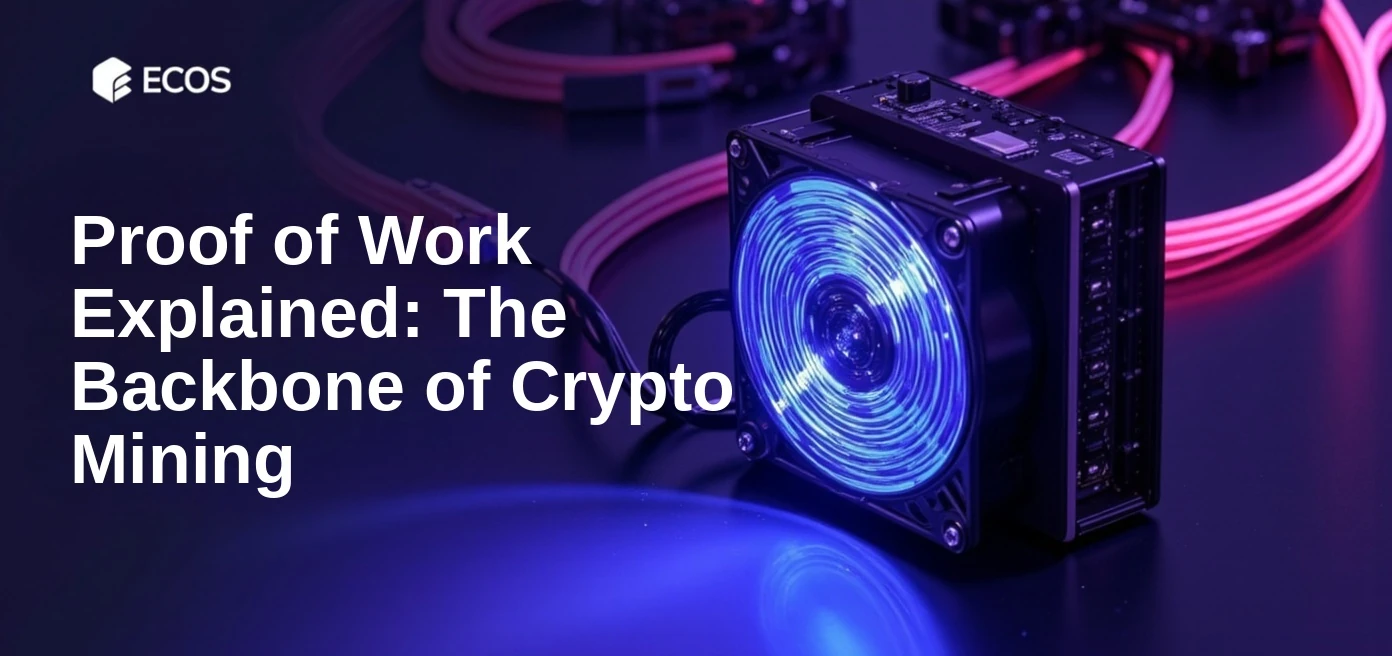Key Takeaways
- Proof of Work is the foundational security mechanism for Bitcoin and many leading cryptocurrencies.
- ASIC miners have revolutionized the efficiency and scale of crypto mining operations.
- Bitcoin maintains a dominant position in the market, with a $2.3T cap and 58% dominance as of October 2025.
- ECOS offers a range of mining solutions, from new and used ASICs to cloud mining contracts.
- Future trends in PoW include ongoing hardware innovation and evolving regulatory landscapes.
Proof of Work (PoW) is the invisible engine that powers the security and trust behind Bitcoin and many leading cryptocurrencies. With Bitcoin’s market cap at $2.3T and the total crypto market exceeding $3.9T as of October 2025, understanding PoW is essential for anyone interested in mining or blockchain technology. This article will break down how PoW works, why it remains the backbone of crypto mining, how it compares to other consensus mechanisms, and how you can participate in the Bitcoin mining ecosystem.
Understanding Proof of Work: The Foundation of Blockchain Security
Proof of Work (PoW) stands as the original consensus protocol underpinning the security of blockchains like Bitcoin. At its core, PoW relies on a simple but robust principle: miners must expend real computational effort to solve complex mathematical puzzles before a block is added to the chain. This requirement ensures that only valid transactions make it onto the blockchain, forming the backbone of cryptocurrency validation practices today.
Blockchain consensus mechanisms, such as PoW, rely on widespread participation by miners, which decentralizes control and builds trust across the network. When a miner successfully solves a puzzle, they broadcast their result—other miners verify this result, promoting accuracy and honesty. This process prevents double-spending and guards against various network attacks, making PoW an essential layer of defense for digital assets.
Bitcoin’s global reputation for security is deeply tied to its unwavering reliance on Proof of Work. However, growing interest in mining requires understanding not just PoW’s strengths but also its energy demands and competition. Here are the most critical actionable aspects of PoW in practice:
- PoW requires miners to solve complex mathematical puzzles: This computational challenge keeps the network secure from malicious actors.
- Ensures only valid transactions are added to the blockchain: Fraudulent or duplicate transactions are rejected by consensus.
- Prevents double-spending and network attacks: The high cost of attack disincentivizes bad actors.
- Rewards miners with cryptocurrency for securing the network: These incentives fuel the ongoing validation process and expand mining participation.
How Proof of Work Works: Step-by-Step
Understanding how proof of work works is essential for anyone interested in blockchain security or the crypto mining process. At its core, mining involves a competitive race among miners, all aiming to solve complex cryptographic puzzles and validate new transaction blocks. These puzzles require miners to use powerful hardware to repeatedly calculate hash functions until they find a result below a predetermined target.
To clarify the process, here are the key steps involved in the crypto mining process for each new block:
- Miners collect and verify pending transactions: Only legitimate transactions get bundled into blocks, helping maintain network integrity.
- A cryptographic puzzle is generated for each block: This puzzle, based on hash functions, ensures unpredictability and fairness.
- Miners compete to find a valid hash below the target: Massive computing power is needed, with success depending partly on luck and partly on hashrate.
- First to solve the puzzle broadcasts the new block: The network quickly validates and appends it to the chain, rewarding the winning miner.
As mining difficulty rises with increased network hashrate, protocols adjust the puzzle’s complexity. This ensures that block creation remains steady over time. Industry Insight: consistently rising difficulty drives demand for more efficient Bitcoin mining hardware like the Antminer S21 Pro, shifting competitive advantage to operators with lower power costs and cutting-edge equipment.

Mining Security Basics: Why PoW Matters
Understanding mining security basics is fundamental when evaluating the resilience of cryptocurrencies like Bitcoin. Proof of Work (PoW) is more than a consensus mechanism—it provides crucial layers of defense. By design, PoW protects against double-spending, ensuring that each Bitcoin cannot be fraudulently reused. This is especially important for maintaining trust in digital currency transactions.
Additionally, PoW equips blockchains with resistance to Sybil attacks, where malicious actors might otherwise attempt to overwhelm the system with fake identities. The network’s reliance on computational power means attackers would need to control a majority of the global hashrate, which is prohibitively expensive and logistically complex.
Before diving into technical details, consider these core industry insights that highlight PoW’s robust design:
- PoW makes attacks costly and impractical: Gaining majority hashrate requires vast capital, hardware, and energy, deterring most would-be attackers.
- Requires majority control of network hashrate for a successful attack: This high barrier creates a natural shield against manipulation.
- Aligns miner incentives with network health: Economic rewards encourage miners to act honestly, protecting both investments and the integrity of the network.
Moreover, energy expenditure in PoW isn’t just a drawback; it acts as a formidable security feature, making dishonest actions economically irrational. As ECOS clients often note, understanding these fundamentals is essential when selecting mining equipment—for instance, weighing new ASICs like the Antminer S21 Pro versus used units, as security depends on up-to-date hardware contributing to the network’s defense.
The Evolution of Proof of Work and Its Alternatives
The historical development of Proof of Work (PoW) stems from early attempts to secure digital currencies against fraud and double-spending. Satoshi Nakamoto’s Bitcoin whitepaper formalized PoW as a mining-based blockchain consensus mechanism—and, since 2009, hardware race began. The emergence of ASIC miners radically boosted hashrates, rendering older CPUs and GPUs obsolete. Newer models, like the Antminer S21, have shifted energy efficiency to the forefront, which directly affects the economics of mining operations.
However, the industry’s focus on efficiency brought environmental debates to the mainstream. As energy use soared, critics raised concerns over the sustainability of crypto mining. These concerns have fueled research into Proof of Work vs Proof of Stake, with PoS gaining traction in major networks like Ethereum. PoS removes the need for massive computational feats, lowering the ecological footprint. For investors, choosing between PoW and PoS coins now involves considerations beyond security and returns; environmental impact plays a growing role in risk assessment.
Comparing leading blockchain consensus mechanisms helps clarify these trade-offs:
| Consensus Mechanism | Energy Use | Security Model | Popular Coins |
|---|---|---|---|
| Proof of Work | High | Economic + Computational | Bitcoin, Litecoin |
| Proof of Stake | Low | Economic (Stake-based) | Ethereum, Cardano |
| Hybrid (PoW/PoS) | Medium | Mixed | Decred |
Many miners struggle to balance sustainability with profitability, especially as global regulations evolve. Solutions that address these pain points—like hosting services or curated hardware—can help safeguard returns in a rapidly shifting consensus landscape.
ASIC Miners: The Hardware Behind PoW
Application-Specific Integrated Circuits (ASICs) have transformed the crypto mining process, offering unmatched power and efficiency over earlier technologies. Their primary role in modern mining lies in executing the Proof-of-Work (PoW) algorithms at speeds simply unattainable for CPUs or GPUs. Because ASIC miners like the Antminer S21 series are engineered specifically for one crypto algorithm, they dominate Bitcoin mining operations—a reality shaping the competitive landscape.
When evaluating mining equipment, understanding key performance metrics is essential. Hashrate, measured in terahashes per second (TH/s), reflects how many calculations a miner completes each second. Power consumption and efficiency (in joules per terahash, J/TH) determine operational costs and sustainability. Higher hashrate and better efficiency often mean quicker returns, but can demand larger upfront investments.
Consider the table below for a direct comparison of popular ASICs from the Antminer S21 family. This data empowers miners to weigh energy efficiency against raw computational power before purchase.
| Model | Hashrate (TH/s) | Power (W) | Efficiency (J/TH) |
|---|---|---|---|
| Antminer S21 XP | 270 | 3645 | 13.5 |
| Antminer S21 Pro | 245 | 3675 | 15.0 |
| Antminer S21 Pro | 234 | 3510 | 15.0 |
However, as ASICs have become essential to the crypto mining process, their dominance has raised concerns about mining decentralization. The high cost of cutting-edge mining equipment may limit access for smaller participants, subtly shifting the power balance toward large farms and institutional operators. This ongoing shift is a crucial industry trend to watch for ECOS users and industry observers alike.

Proof of Work in the Current Crypto Market
As of October 2025, the cryptocurrency landscape is shaped decisively by proof of work mechanisms, with Bitcoin at its core. Bitcoin’s market cap has surged to $2.3 trillion, cementing its role as the leading player in digital asset markets. Its dominance, now at 58%, reflects both investor confidence in its security and the continued relevance of cryptocurrency validation through proof of work explained by its robust network effects.
To provide perspective, the total crypto market cap stands at $3.9 trillion, with over 9,500 active cryptocurrencies. However, the share of PoW coins in this market has narrowed as newer consensus models emerge. Despite this, Bitcoin’s overwhelming dominance shows that proof of work validation maintains utility, especially where network security and decentralization are paramount.
Comparing key metrics offers further clarity:
| Metric | Value (Oct 2025) |
|---|---|
| Bitcoin Price | $116K |
| BTC Market Cap | $2.3T |
| BTC Dominance | 58% |
| Total Crypto Market Cap | $3.9T |
| Active Cryptocurrencies | 9,500+ |
Industry Insight: While over 9,500 cryptocurrencies compete, Bitcoin’s proof of work infrastructure continues to set the gold standard, influencing both equipment choices and strategic positioning for serious market participants.
From Theory to Practice: Joining the Bitcoin Mining Ecosystem
Transitioning from understanding the proof of work explained in theory to actually participating in the crypto mining process can be both exciting and daunting. The key lies in choosing the right approach and aligning resources with your risk appetite. Individuals can become miners by purchasing or renting mining equipment, or by opting for cloud-based mining solutions.
Those looking to enter the field can take advantage of specialized platforms that simplify mining. The explore ECOS ASIC mining marketplace offers a curated ecosystem where users can compare, purchase, or rent ASIC miners securely hosted in ECOS data centers. This approach minimizes logistical headaches and speeds up deployment.
For anyone evaluating the pros and cons, the following options offer various benefits and flexibility, depending on your investment goals:
- Purchase new or used ASIC miners hosted in ECOS data center: Immediate access to professional infrastructure with reduced operational complexity.
- Rent ASIC miners for flexible contract durations: Adjust exposure based on market trends without long-term hardware commitments.
- Start mining immediately with no installation delays: Bypass traditional waiting times and benefit from faster earnings potential.
- Explore cloud mining contracts for low-barrier entry: No need for upfront hardware investment, making it easier for newcomers to learn the crypto mining process firsthand.
Industry Insight: Flexible contract durations particularly appeal to investors keen to hedge against hardware obsolescence or market volatility.
ECOS: Buy, Rent, or Cloud Mine
The ECOS provides a one-stop shop for miners at every stage, from newcomers exploring their first mining equipment to experienced investors scaling up operations. New offerings, like the Antminer S21 series (188–270 TH/s), set a high bar for efficiency in the crypto mining process, appealing to those aiming for future-ready deployment. For users seeking flexibility without a long-term commitment, ECOS offers ASIC rentals with durations up to 24 months, making it easier to adapt to shifting market conditions.
For those evaluating cost versus performance, the marketplace also features pre-owned miners, many with only 20–430 days of previous use. This segment attracts budget-conscious miners looking to optimize capital expenditure while still participating in the crypto mining process. Alternatively, cloud mining contracts starting from 6 TH/s allow individuals to mine Bitcoin without ever handling physical hardware, reducing technical risks and simplifying daily operations.
Many ECOS clients appreciate the platform’s operational support and risk-mitigation features:
- All equipment hosted and maintained in ECOS data center: This ensures both uptime and regular hardware monitoring.
- Immediate mining start for marketplace purchases: Users can begin earning as soon as a transaction is completed.
- 6-month warranty on new and used equipment: This minimizes risk, which is critical for capital-intensive mining investments.
- Flexible power packages for cloud mining: Optimize costs based on evolving market needs.
ECOS’s approach bridges the gap between retail and institutional miners, empowering users to adjust strategies as hardware, Bitcoin price, or network difficulty changes.
The Future of Proof of Work: Trends and Takeaways
Examining proof of work explained through a future-focused lens reveals important developments for the crypto landscape. As blockchains mature, the long-term outlook for PoW remains linked to operational efficiency and adaptability. Major networks like Bitcoin will likely keep PoW as their security backbone, but miners must navigate evolving regulatory and environmental expectations. Increasing scrutiny over energy use may fuel demand for renewable-powered facilities and incentivize innovation in ASIC mining hardware.
Recent trends show a push toward next-generation equipment, with leading models continuously improving performance per watt. The potential for hardware innovation, such as immersion cooling or the use of modular systems, enables miners to optimize operations amid challenging market conditions. Investors should note that the future of crypto mining will favor those agile enough to adopt new technologies early and manage operational risks thoughtfully.
Regulatory changes can create both challenges and strategic opportunities for mining businesses. For example, jurisdictions offering tax benefits or green energy incentives may attract large-scale migration of mining operations. Ultimately, robust infrastructure decisions—choosing between upgrading to the latest miners or maximizing existing hardware—will shape profitability and competitiveness for ECOS users and beyond.
Key Insights and Strategic Outlook
Proof of work explained: it remains the cornerstone of Bitcoin’s security, safeguarding the blockchain through transparent, decentralized validation. Despite the rise of alternative consensus mechanisms, mining security basics derived from PoW reinforce trust in major cryptocurrencies. Notably, coins like Bitcoin and Litecoin, which rely on proof of work, continue to dominate total crypto market value, making their resilience essential for investors seeking long-term reliability.
The relentless pace of ASIC innovation drives ongoing improvements in mining efficiency. As new models deliver greater hashrate with lower power consumption, miners—both new and experienced—gain opportunities to optimize operations for shifting market conditions. This evolving landscape opens doors for industry newcomers, thanks to user-friendly cloud mining platforms and accessible hashrate marketplaces.
To highlight the market’s practical dynamics:
- PoW secures over half of total crypto market value: Bitcoin and similar coins outpace competitors by network value.
- ASIC miners continue to evolve for greater efficiency: Equipment upgrades boost competitiveness and ROI potential.
- Cloud mining and marketplaces lower entry barriers: Even small-scale operators now access professional tools once reserved for major players.
- Environmental debates may shape future regulations: Staying adaptive and energy-aware will matter most for those seeking sustainable growth.
What is Proof of Work in simple terms?
Proof of Work is a consensus mechanism where miners solve complex puzzles to validate transactions and secure the blockchain, earning rewards for their efforts.
How does Proof of Work secure cryptocurrencies like Bitcoin?
PoW makes it extremely costly and difficult for attackers to alter the blockchain, as they would need to control the majority of the network’s computational power.
What is the difference between Proof of Work and Proof of Stake?
Proof of Work relies on computational effort and energy, while Proof of Stake selects validators based on the amount of cryptocurrency they hold and are willing to ‘stake’ as collateral.
Can I start mining Bitcoin without owning hardware?
Yes, cloud mining services like those offered by ECOS allow you to participate in Bitcoin mining without purchasing or managing physical equipment.
Are used ASIC miners a good investment?
Used ASIC miners can be a cost-effective entry point, especially when purchased from reputable marketplaces like ECOS, which provide maintenance and warranty support.




